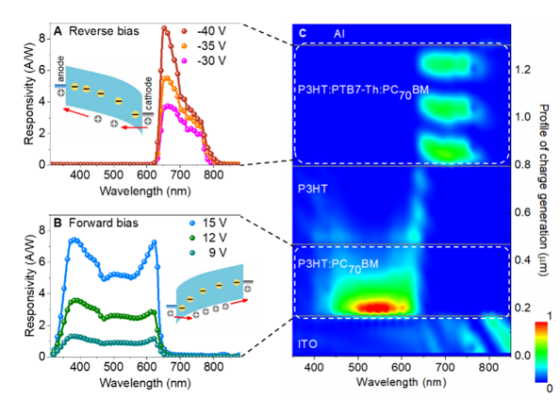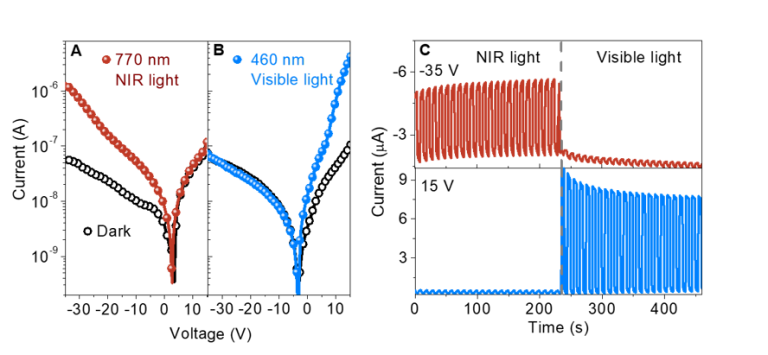Research conducted at Southern University of Science and Technology (SUSTech) has found a new direction for dual-mode organic photodetectors (OPD) that incorporate switchable spectral responses. This new research strategy for OPDs offers an attractive option for environmental pollution detection, bioimaging, wellness, and security monitoring in two distinct bands.
SUSTech Department of Electrical and Electronic Engineering (EEE) Associate Professor Dan Luo worked with Hong Kong Baptist University (HKBU) Department of Physics, Professor Furong Zhu. Their paper titled “Near-infrared and visible light dual-mode organic photodetectors.” was published in the high-impact journal Science Advances (IF = 12.804).
Thin-film dual-mode OPDs present a promising alternative to conventional inorganic photodetectors. The advantages of dual-mode OPDs include a more cost-effective fabrication process and more flexibility. The rapidly developing photodetection applications such as machine vision, self-driving cars, and multi-output light communication are stimulating ever-increasing demanding for photodetectors. They are needed explicitly for their photoresponsivity as well as their spectral properties.
Great efforts have been devoted to the development of switchable spectral OPDs, with most reported examples relying on exposing the OPD to light from different directions. Dual-mode OPDs with switchable spectral responses can be operated without flipping the detectors remains an on-going challenge for researchers.
What is unique about the dual-band OPDs is that they can detect two distinct wavelengths of light in the near-infrared (NIR) and visible light spectrums. Such high detection abilities offer significant commercial applications in a wide range of fields.
The researchers constructed a three-layered organic stack for their dual-mode OPD. It consists of a visible light absorber, optical spacer, and an NIR light absorber. The three layers were able to detect NIR and visible light, which is a previously unreported outcome. The NIR and visible light responses in the dual-mode OPD are closely related to the different electron distributions and the polarity dependent charge behaviors.
In the presence of NIR light, the tunneling hole injection occurs at the NIR light absorber/cathode interface in the OPD operated at reverse bias. It occurs due to the band bending induced by the high density of NIR light-generated electrons. In the presence of visible light, the tunneling hole injection takes place at the anode/visible light absorber interface in the OPD at the forward bias. This particular hole injection occurs due to the band bending because of the high density of visible light-generated electrons. The dual-mode OPD has a high responsivity above 10 A/W at two different wavelengths

Figure: The dual-mode OPD analysis of (A) photoresponsivity spectrum under reverse biases, (B) photoresponsivity spectrum under forward biases, (C) profile of charge generation in the OPD devices.
The dual-mode OPD exhibits visible-blind NIR response at reverse bias while the current in the forward-biased region remains as dark current. It builds up a NIR-blind visible response at forward bias, and the reverse current remains as dark current. The temporal current clearly shows that a stable photoresponse is established in the reverse-biased OPD when exposing to 0.1 Hz modulated NIR light sources. After a visible light source replaces the light source, the photocurrent decreased to zero, indicating its insensitive nature to the visible light when it is operated in its NIR light detection mode. On the other hand, the forward-biased OPD responds only to the visible light with almost no photoresponse to the NIR light.

Figure: The dual-mode OPD performances of (A) I‒V characteristics under NIR light, (B) I‒V characteristics under visible light, (C) temporal current of OPD operated at reverse bias -35 V and forward bias 15 V under NIR and visible light.

Developing a high-performing bias-switchable spectral response OPD in two distinct NIR and visible light bands is a critical breakthrough to achieve. The trilayer OPD concept described in this work is universal and can be adopted for making dual-mode photodetectors at different wavelengths. The on-going works focus on reducing the driving voltages and expanding the spectral bands in the dual-mode OPDs.
SUSTech-HKBU joint trained doctoral candidate Zhaojue Lan is the first author of the article. Zhaojue Lan graduated in 2016 from EEE and then joined the SUSTech-HKBU joint Ph.D. training program. Late last year, he received the Journal of Materials Chemistry A Poster Prize from the 11th Asian Conference on Organic Electronics (ACOE-2019) for the poster presentation titled “Near-infrared and visible light dual-mode organic photodetectors.”
This work was financially supported by the Research Grants Council (University Grants Committee, Hong Kong), General Research Fund, Hong Kong Baptist University Inter-institutional Collaborative Research Scheme, and State Key Laboratory of Environmental and Biological Analysis.
Article link: https://advances.sciencemag.org/content/6/5/eaaw8065
Proofread ByXia Yingying
Photo ByDepartment of Electrical and Electronic Engineering, Qiu Yan